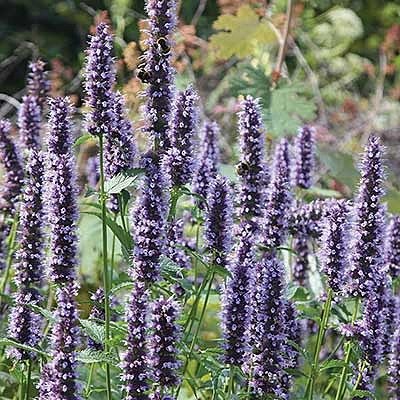
Gardening Journal: Plant of the month – Agastache Black Adder
July is a month for heat, colour and drama in the garden. Many of the shrubs have done their thing but the herbaceous keep going rewarding the gardener with more and more flowers day after day. It can be a dry month too, to keep plants performing well it is essential to keep them well fed and watered. Ideally this is done less often but for longer – giving the plants a really good drink rather than just splash is a better way to keep your plants happy and hydrated.Agastache is a short-lived herbaceous perennial with blue flowers and fragrant foliage that can be used as an ornamental or in the herb garden.
This plant is in the mint family (Lamiaceae) which has small mint like leaves with hints of liquorice and citrus. The fresh and dried leaves of the plant have been used traditionally for food seasoning and making tea, it was also used medicinally by Native Americans to treat coughs, fevers, wounds, and diarrhoea.
Agastache is a upright, clump-forming plant that generally grows to about 1.2m tall. The foliage remains nice looking throughout the season and sometimes has a purplish cast on the new growth. However, it’s the dense spikes of powder-blue flowers that really steal the show in mid to late summer. The genus is also a magnet for wildlife - bees, butterflies, and other insects love to drink from the nectar-rich flowers. If you periodically deadhead spent flower spikes, you'll extend the flowering season too.
While it’s not the hardiest of plants it can survive better through the winter months if the foliage and flower stems are left through the winter and cut back in spring when the danger of frost has long gone. A good mulch of compost is not a bad thing either. Agastache prefer to be grown in full sun to light shade in fertile, well-drained soil, they dislike their feet getting wet in the winter so beware those of you with badly drained soil.
Whether grown as an annual or perennial, Agastache is incredibly floriferous in the garden and a great mixer and filler in summer borders. I like to combine it with other perennials of similar habit and continuous summer bloom like salvias & Catmints. It also looks great in a naturalistic scheme and can happily accompany many types of ornamental grass, miscanthus being one of a few. It is best used as a mid to back of the border plant but can sneak in at the front too.
Ultimately, it’s a valuable perennial that is worth taking the risk as to whether you will see it again next year... or not.
Jobs to be Done:
Ornamental Garden:
• Continue to deadhead herbaceous perennials and roses as flowers go over.
• Weed!!!
• Continue to edge borders.
• Cutback oriental poppies once flowered.
• Divide bearded irises if flowering is declining – re plant the youngest rhizomes.
• Deadhead roses.
• Trim evergreen hedges.
• Turn compost heaps.
• Cut back spent flowers of climbing hydrangea.
• Feed dahlias/cannas etc.
• Take cuttings of clematis.
• Sow biennials.
Vegetable Garden:
• Thin dessert apples and cooking apples.
• Sow spring cabbages and plant out winter cabbages.
• Water courgettes consistently to encourage a good crop.
• Mulch long term crops like brassicas.
• Water fruit trees/bushes.

